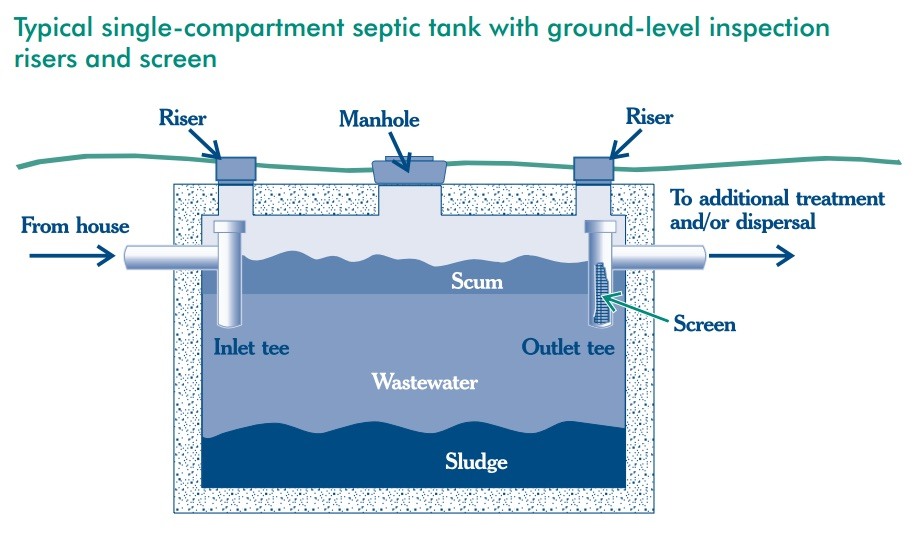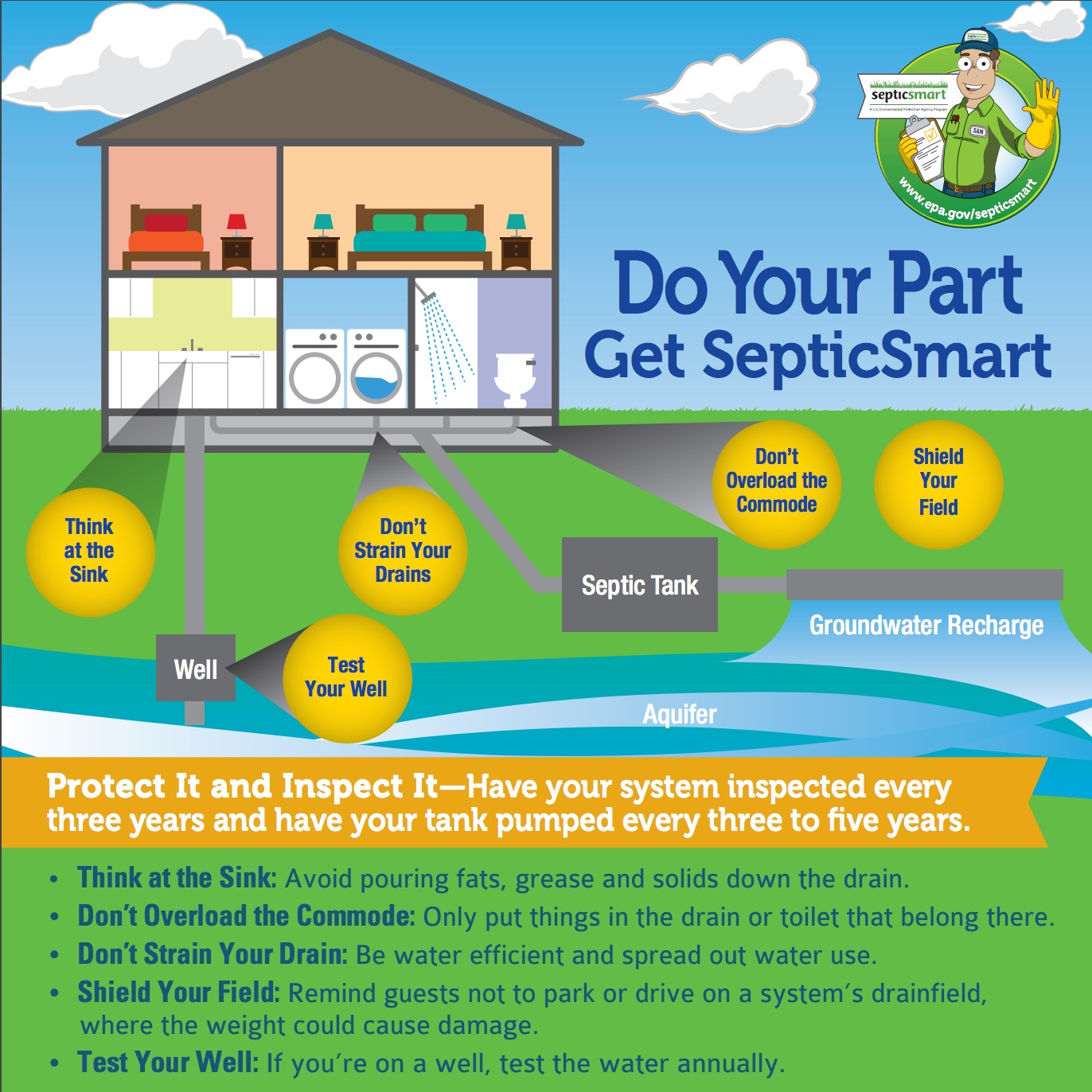Septic Tank Ownership Tips for SepticSmart Week
Enjoy reading the latest DIY articles and saving money?
Receive our latest helpful hints, tricks and savings, directly to your inbox.
Posted June 1, 2017
Did you know that September 16-20 marks the end EPA’s SepticSmart Week? If you are a homeowner that owns a septic tank, this outreach is for you. If you don’t know if you have a septic tank, ask yourself:
-
- Do you use well water?
- Do you have a $0.00 charge for Sewer Amount?
- Do your neighbors have septic tanks?
During SepticSmart Week, homeowners are encouraged to learn about proper septic care and take part in maintenance activities. Taking care of your septic tank not only benefits you and your wallet, but also helps sustain the local water supply.
If you would like to help raise awareness of this important community concern, you are encouraged to:
-
- Host an event
- Distribute SepticSmart materials
- Schedule septic tank maintenance
- Pledge to properly maintain your system
- Getting local and state government involved water concerns
- Participating with the hashtag #SepticSmartWeek
Many homeowners and urban dwellers don’t have to worry about anything when it comes to the way their blackwater (water from toilets) is disposed of, but we all take part in the septic system. It’s important to understand the basics of how a septic tank works so we can all understand our role and responsibility in the water treatment process.
Click here for ways to improve the water quality for your home and community.
What is a septic tank?
Septic tanks are underground wastewater containers that treat the water coming from your home.
Septic tank synonyms:
-
- on-lot system
- onsite system
- individual sewage disposal system
- onsite sewage disposal system
- onsite wastewater treatment system
How does a septic tank work?
This is a simplified explanation, but covers all of the basics.
Source: epa.gov
All the water from your home gets funneled into one main drainage pipe. The contaminated water gets transported from a main drainage pipe to the septic tank located in an underground area near your house.
In the septic tank, the water remains until the solids sink to the bottom, where bacteria help to break it down. To prevent too much sludge and scum, you will eventually need to have your septic tank pumped (every 3 – 5 years). Inlet and outlet tees help prevent the sludge from escaping.
Once the oils and sludge has been separated, the wastewater is released into a nearby drainfield, where it percolates under the soil (proper soil is necessary).
Some systems use alternative material to treat the wastewater, such as sand, peat, or plastic. Still in other systems, the water may drain to nearby wetlands, lagoons, or a separate disinfection system. Alternative septic systems should be professionally inspected every year.
Septic Tank Ownership Tips
If you own a septic tank, you are responsible for it. That means professional maintenance, vigilant care, and proper treatment. The main benefits of proper maintenance are cost savings and environmental protection.
1. Get a professional inspection
If you are buying a home and it has a septic tank, make sure it is professionally inspected before you move forward. Important information to gather includes the age and location of the septic tank, including any installation and maintenance details. Some signs of a damaged septic tank system are damaged vents, soggy lawns, and odors.
If your home inspector recommends a specialist, get one. You should have almost everything in the home inspected, including HVAC, electrical, and plumbing systems.
As a septic tank owner, you are now responsible for regular maintenance and pumpings.
Have your septic tank inspected by a licensed professional every 3 years. Schedule septic tank pumpings whenever necessary or every 3 – 5 years. Alternative septic systems should be inspected annually.
Professional septic tank inspections include:
-
- Locating the tank and uncovering access holes and vent stacks
- Testing plumbing system for proper drainage
- Checking for odors and signs of a backup
- Measuring sludge and scum layers
- Detecting leaks and other structural issues
- Testing and inspecting mechanical parts
- Pumping sludge if necessary
2. Watch what goes down your drains
One of the most important factors for maintaining the health and effectiveness of your septic system is to watch what goes down your drains.
You may already know not to pour chemicals, grease, oil pesticides, gasoline, antifreeze, or paint down your drains, but read on to find out about the things you may not know about.
Toilets:
There are only two things that should ever go down your toilet: human waste and toilet paper. It’s simple. But, that means no wet wipes, feminine hygene products, tissues, paper towels, Q-tips, or anything else. Read our blog for more information about what NOT to throw down your toilet and why it’s so important.
Laundry Room:
Many people don’t realize that running multiple loads of laundry during the day can put excess strain on your septic system, risking flooding to the drainfield. Consider spreading out your washes over the week and switching to a more energy and water efficient washer, such as an ENERGY STAR washer.
Kitchen Sinks/Garbage Disposal:
Grease, oil, chemicals, paint, and other household products separate from the wastewater in your septic tank and eventually need to be properly disposed of. Reduce the amount of scum and sludge that enters your drainage system or prepared to spend more time and money on septic tank inspections and pumpings.
For the sake of your garbage disposal and your septic system, do NOT put these items in the garbage disposal:
-
- Grease, oil, and fats
- String and starchy vegetables (celery, etc.)
- Pasta, rice, and other expandable foods
- Hard stuff like bones and pits
- Glass, metal, plastic, paper
- Large amounts of any solids
Read our blog for more information on how to clean, maintain, and repair your garbage disposal.
If you are an urban dweller, you still have a responsibility to watch what goes down your drains. Watch this video to learn more about the sewage treatment process:
3. Use water efficiently
Too much water entering the septic tank can cause overflow and flooding problems. Besides saving money on your water bill, you can help maintain your septic system by watching hoe much water you use.
Luckily, there are some easy ways to minimize your use of water:
-
- Switch over to low-flow plumbing fixtures and high-efficiency toilets.
- Install or replace faucet aerators
- Run full loads of dishes and laundry
- Periodically test your plumbing system for leaks
- Take shorter showers and be mindful of water waste
- Upgrade to energy-efficient appliances
- Only use toilets for flushing toilet paper and human waste
- Sign up for a plumbing maintenance plan or remember to schedule professional plumbing maintenance every year
3. Care for your drainfield
If you aren’t taking proper care of your drainfield, you risk sewage flooding your property, damaged vegetation, and much more. Make sure you are taking care of your drainfield by:
-
- Planting only grass and removing any trees or plants that can cause root intrusion
- Not driving or parking on the drainfield. The soil can compress and damage parts of your septic system.
- Diverting other water sources away from the drainfield. Make sure rainwater, sump pump drains, and other excessive water is diverted elsewhere. Drainfield flooding is a common problem that can cause septic tank problems and plumbing fixture backups.
Top 10 Ways to Be a Good Septic Owner
Download and share the image from epa.gov to help with septic system education and awareness.
 Daily Promotion
Daily Promotion
$500 Off Tankless Water Heater
Upgrade your comfort and give back this season.
Get Promotion


